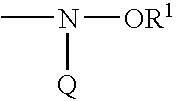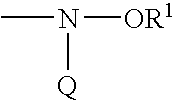Amine functionalized polymer
a functionalized polymer and amine technology, applied in the field of polymer manufacturing and use, can solve the problem of difficult attachment of certain functional groups
- Summary
- Abstract
- Description
- Claims
- Application Information
AI Technical Summary
Benefits of technology
Problems solved by technology
Method used
Image
Examples
examples
[0062]In the examples, dried glass vessels previously sealed with extracted septum liners and perforated crown caps under a positive N2 purge were used for all preparations. Butadiene (21.9% by wt. in hexane), styrene (33% by wt. in hexane), hexane, n-butyl-lithium (1.54 M in hexane), oligomeric oxolanyl propanes (1.6 M solution in hexane, stored over CaH2), and butylated hydroxytoluene (BHT) solution in hexane were used.
[0063]Commercially available reagents and starting materials included the following, all of which were acquired from Sigma-Aldrich Co. (St. Louis, Mo.) and used without further purification unless otherwise noted in a specific example: 1-nitrosopyrrolidine, nitrosobenzene, 2-nitrosotoluene, N,N-dimethyl-4-nitrosoaniline, N,N-diethyl-4-nitrosoaniline, 2-chloro-2-methylpropane, (1-bromoethyl)benzene, and bromodiphenylmethane.
[0064]Testing data in the Examples was performed on filled compositions made according to the formulation shown in Tables 1a (carbon black only) ...
examples 1-5
[0069]To a N2-purged reactor equipped with a stirrer was added 1.78 kg hexane, 0.38 kg styrene solution, and 2.32 kg butadiene solution. The reactor was charged with 3.67 mL n-butyllithium, followed by 1.05 mL of the OOPs solution.
[0070]The reactor jacket was heated to 50° C. and, after ˜30 minutes, the batch temperature peaked at ˜54° C. After an additional ˜25 minutes, the polymer cement was transferred from the reactor to dried glass vessels.
[0071]Three samples were terminated with, respectively, 1-nitrosopyrrolidine (sample 2), nitrosobenzene (sample 3), 2-nitrosotoluene (sample 4), and N,N-dimethyl-4-nitrosoaniline (sample 5) in a 50° C. bath for ˜30 minutes. These and a non-functionalized polymer (sample 1) were coagulated in isopropanol containing BHT and drum dried.
[0072]Using the formulation shown in Table 1a, vulcanizable elastomeric compounds containing reinforcing fillers were prepared from samples 1-5. Results of physical testing on these compounds are shown below in Ta...
examples 6-10
[0075]The procedure described with respect to Examples 1-5 was, in substantial part, repeated. In sample 6 (control), the living polymer was terminated with isopropanol. The living polymers in samples 7-10 were reacted with N,N-dimethyl-4-nitrosoaniline; the polymer from sample 7 was terminated, thus forming a hydroxylamine functional group, while the polymers from samples 8-10 were reacted with, respectively,[0076]8—2-chloro-2-methylpropane,[0077]9—(1-bromoethyl)benzene, and[0078]10—bromodiphenylmethane.
[0079]Using the formulations from Tables 1a and 1b above, vulcanizable elastomeric compounds containing reinforcing fillers were prepared from samples 6-10. Results of physical testing on these compounds are shown below in Table 3. For those rows that include two data points, the upper is for a formulation from Table 1a, and the lower is for a formulation from Table 1b.
[0080]
TABLE 3Testing data from Examples 6-10678910Mn (kg / mol)122188186187186Mw / Mn1.041.291.331.321.29% coupling065....
PUM
| Property | Measurement | Unit |
|---|---|---|
| temperature | aaaaa | aaaaa |
| temperatures | aaaaa | aaaaa |
| volume fraction | aaaaa | aaaaa |
Abstract
Description
Claims
Application Information
 Login to View More
Login to View More - R&D
- Intellectual Property
- Life Sciences
- Materials
- Tech Scout
- Unparalleled Data Quality
- Higher Quality Content
- 60% Fewer Hallucinations
Browse by: Latest US Patents, China's latest patents, Technical Efficacy Thesaurus, Application Domain, Technology Topic, Popular Technical Reports.
© 2025 PatSnap. All rights reserved.Legal|Privacy policy|Modern Slavery Act Transparency Statement|Sitemap|About US| Contact US: help@patsnap.com


